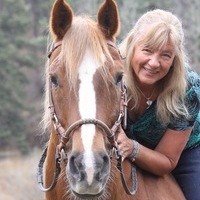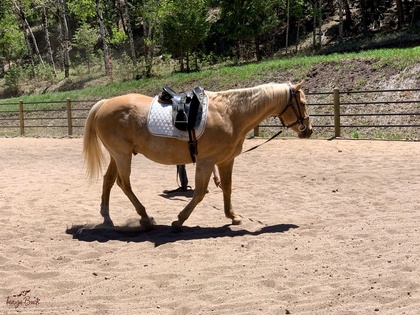Dressage is nothing more than training. Period. And training is nothing more than having a nice conversation with your horse where both parties understand each other. So why is thinking about entering this seemingly elite world of dressage so daunting?
Let’s simplify it down to the core, shall we? Let’s not use all the French, German or other fancy terms and let’s talk about how to best communicate with your horse to get what you want. In fact, let’s get rid of the traditional tack and let’s ride how we most like to; bareback, English, western, it doesn’t matter. What does matter is that you keep in mind the goal: practicing the highest form of training that you are capable of doing with your horse. Fine, good, you think, and what does that look like, exactly?
The straightforward answer is: It looks invisible. It’s silent, it’s precise, intentional and it’s two-way dialog between you and your horse. You will want to work on using your mind, body, intention, and energy to communicate with your horse in a way you maybe have always done, or maybe you learn a whole new way.
There are lots of books, videos, clinics, webinars, lectures, etc., on dressage. And you’ve likely watched, read and gone to some. “How to” advice is everywhere and in the horse world, it’s usually contradictory. Skip all that. Here are some basic-good-horsemanship things to help you get started and to stay on the right track.
-
Have fun! Remember that dressage is training, and training is helpful to both you and your horse and having a good time is essential. If you’re bored, so is he. If you’re struggling, so is he. Take your time learning to be perfect if that’s your goal.
-
Strip. Remove all artificial aids besides a bridle or halter. Keep your saddle, or not. We’re starting over here pretty much, so unless you feel unsafe without your whip and spurs (though I can’t see how either would keep you safe) lose all but the bare necessities.
-
Feel. Teach yourself to feel where your horse is under you. Can you tell where each foot is when he’s standing? When he’s walking? Trotting?
-
Learn the size of a 20 meter circle, both on and off of your horse. Do this using a lunge line or round pen since a 20 meter circle is about the same as a 60 foot circle. Watch your horse move around it at a walk and trot. Notice how his spine bends, or doesn’t on the circle. Go both directions. Watch for asymmetry.
-
Practice soft aids and cues. Do the least amount of any action (cue) to get the response you are after. If you have a safe fenced-in place such as a round pen, take your reins off of your bridle—doesn’t matter what kind of bridle it is, remove them—and replace them with a string. You can use baling twine, but it’s a bit too heavy, so something smaller in diameter is best. Practice learning feel by holding the string by threading each “rein” between your thumbs and forefingers, and allowing the slack to drop down through your fists. You’ll be amazed at how little pressure it takes to get your horse to respond!
-
Use your brain. This means before asking for anything, be very clear on what you want. Make the explanation short—ten words or fewer. Once clear, you will be able to be concise.
-
Step by step. Don’t set a goal of doing a side-pass until you’ve set the first goal of teaching your horse to listen to your subtle aids asking for him to first open his shoulder, then his haunch. Both are easy to teach; begin by asking for him to step to the side with only his front end —the beginning of turn on the haunches, and then to step to the side with only his hind end—the beginning of turn on the forehand.
-
Light and soft. By learning to do less and get more, you are beginning to understand how to manipulate and control each part of your horse’s body. Think of it as if your horse is inside of a cube and practice opening the sides and ends to move him in any one direction. It’s a fun game that you’ll both like if you take it slowly and are consistent. Teaching him to think about each step will teach him to listen and respond with a focus you may not be aware he has.
-
Take your time! Each maneuver with a horse takes much longer than we think and can be broken down into so many more pieces than we believe. For example, think about how you take a step, and begin to walk. Even without a horse, what do you do when you are going to go from where you are to where you want to be? Break it down into as many pieces and parts as possible. ***I’ll put the answer to this question at the end of this article.
-
Learn what “Impulsion” means. Then, watch your horse while he’s at liberty. How does he move? Does he pull himself along or does he engage his hindquarters? This one thing will dictate how you begin your and your horse’s dressage lessons, so understanding what is natural for your horse is invaluable.
-
Evaluate yourself and how you sit the horse. Photos and video are your best friend for this. Look at your posture, your eyes, your legs, your way of sitting. Are you balanced? Is your horse? Fix what you think you are able to do on your own, then reshoot and reevaluate.
Once you feel you and your horse are on the same page, communicating well, you know your hands and seat are working together with your legs as best you are able, then it’s time to maybe get an instructor to come help iron out the rough spots. Until then, learn the letters and where they go in a dressage court!
***ANSWER to how many steps it takes to begin walking:
-
Think about where you are going.
-
Look at where you want to go.
-
Raise your energy in preparation of moving.
-
Lean forward—this is true with or without the horse, and notice how little movement is needed.
-
Lift your leg. On the horse, you’ll squeeze your thighs lightly.
-
Put your foot forward.
-
Shift forward until you are off balance.
-
Catch yourself with your foot.
-
Repeat.
Keep riding, make it fun and enjoy your horse, Happily Ever After!
~Tanya Buck
FREE Today: Balancing both you and your horse, plus you will be signed up for other free goodies all year! https://lp.constantcontactpages.com/su/ou9pQ9C/balancetips



